Planning a 6-day Ireland itinerary can be a pain in the backside… So, we’ve done all of the hard work for you!
We’ve spent 25+ years travelling around Ireland and the itinerary below leans on that experience and the many mistakes we made along the way!
In a nutshell, this 6-day itinerary:
- Has been meticulously planned
- Has an hour-by-hour itinerary for each day to save you time/hassle
- Follows logical routes that take yaou to hidden gems, tourist favourites and great pubs and restaurants
Who this itinerary will suit

Now, before you scroll down, take 10 seconds to look at the graphic above – each of our road trip itineraries have been tailored to specific needs.
This road trip is specifically for those of you:
- Starting in/near Dublin
- Using your own car/a rental (if you’re renting a car, read this Irish car rental guide – it’ll save you time and hassle)
- Looking to explore at a fast pace
- With a good level of fitness (i.e. it includes long walks and hikes)
- Remember, we have hundreds of different itineraries here if this one doesn’t suit you
An overview of this 6-day Ireland itinerary

Click here for a high res map
The map above gives you a very high-level overview of where this route will take you.
It uses several bases (e.g. Dublin for 4 nights) and provides you with day-long road trips you can head off on, so you avoid having to change accommodation constantly.
Now, I’ll stop rambling on – here’s a day-by-day insight into each of the days below!
Day 1: Arrive in Dublin

Photos via Shutterstock
Day 1 of this 6 day Ireland itinerary is going to be very dependent on the time that you arrive into Dublin. If you need to rent a car, I’d recommend collecting one at Dublin Airport. While you won’t need it for the first day in the city, it’ll save you from having to go and collect one at a later time.
For this itinerary, we’re going to make an assumption that you’ve landed in the morning and are ready to explore from mid-afternoon.
Recommended accommodation in Dublin
- Budget: Abigail’s Hostel (Temple Bar), Jacobs Inn (central hostel) and the Generator Hostel (short walk from the city)
- Mid-range: Dublin Skylon Hotel (just outside the city), Wren Urban Nest (Temple Bar) and the Harding Hotel (very central)
- Luxury: The Merrion (St. Stephen’s Green – very central) and The Westin (just off Grafton Street)
Getting around Dublin + money savers
- Time savers: If you want to avoid walking where possible, it’s worth getting a ticket for the Hop On Hop Off Bus around Dublin. It goes to or near all of the main sites on this itinerary plus plenty more.
- Money saver: If you’re visiting the ‘main’ Dublin attractions, the Dublin Pass can save you €€€ (here’s how)
Stop 1: Lunch

Photos © Tourism Ireland
There’s plenty of great restaurants in Dublin that serve up a delicious lunch, but if you fancy a tasty bite in a lovely old-world-style pub, Neary’s just off of Grafton Street is hard to bate!
They serve simple dishes (like soups and sandwiches) that are packed with flavour and great value for money. Alternatively, Sprout and Co. on Dawson St. is also a great choice.
They have a range of hearty salad bowls, with good options for vegetarians and vegans.
Stop 2: Trinity College

Photos via Shutterstock
Now you’re all fuelled up, it’s time to head to Trinity College to see the Book of Kells, arguably the most famous cultural attraction in Dublin.
If you can, we highly recommend pre-booking your tickets online, as the queues can get really long (bordering on ridiculous!). This fast-track ticket allows you to dodge the queue and gets you into Dublin Castle, too!
Spend around one hour seeing the Book of Kells, walking around the exhibit, and taking in the beauty of the Old Library. After that, give yourself another 20 minutes or so to walk around the university campus.
Stop 3: The Ha’penny Bridge (via Temple Bar)
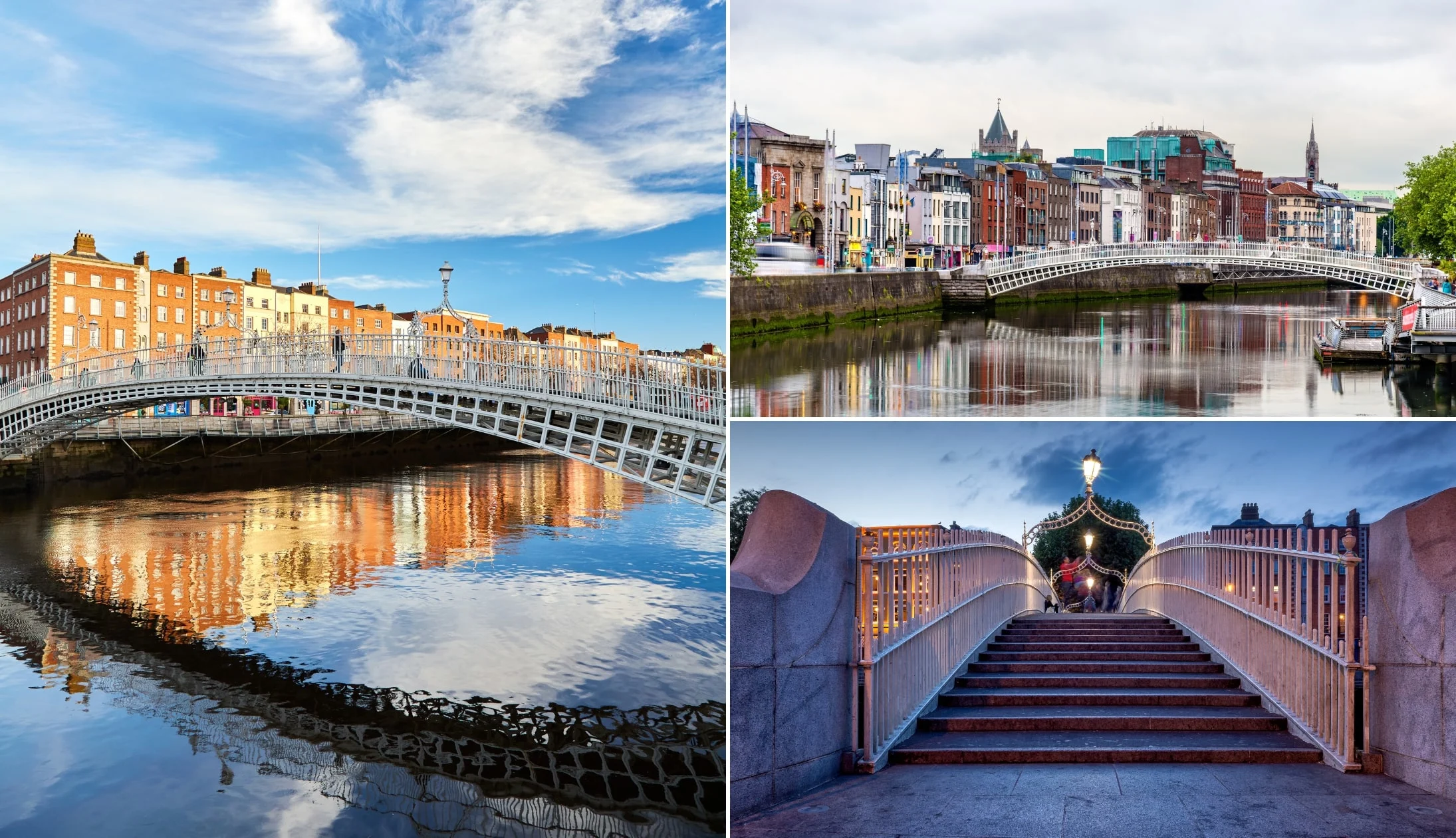
Photos via Shutterstock
The Ha’penny Bridge (officially named the Liffey Bridge) dates back to 1816 and was the first pedestrian bridge over the River Liffey!
It’s a seven-minute walk from the Trinity Gates, but feel free to take your time as you make your way through the lively streets of Temple Bar.
Now, Temple Bar can be a bit of a tourist trap. If you fancy a pint, here are several pubs in Temple Bar worth trying (the Palace is our go-to).
If you feel like an afternoon coffee, there are some great cafes in the Temple Bar area or on the other side of the river. Joe’s Coffee and Vice Coffee are two of our favourites across the water.
They’re both just a short stroll from the north side of the Ha’penny Bridge.
Stop 4: Dublin Castle
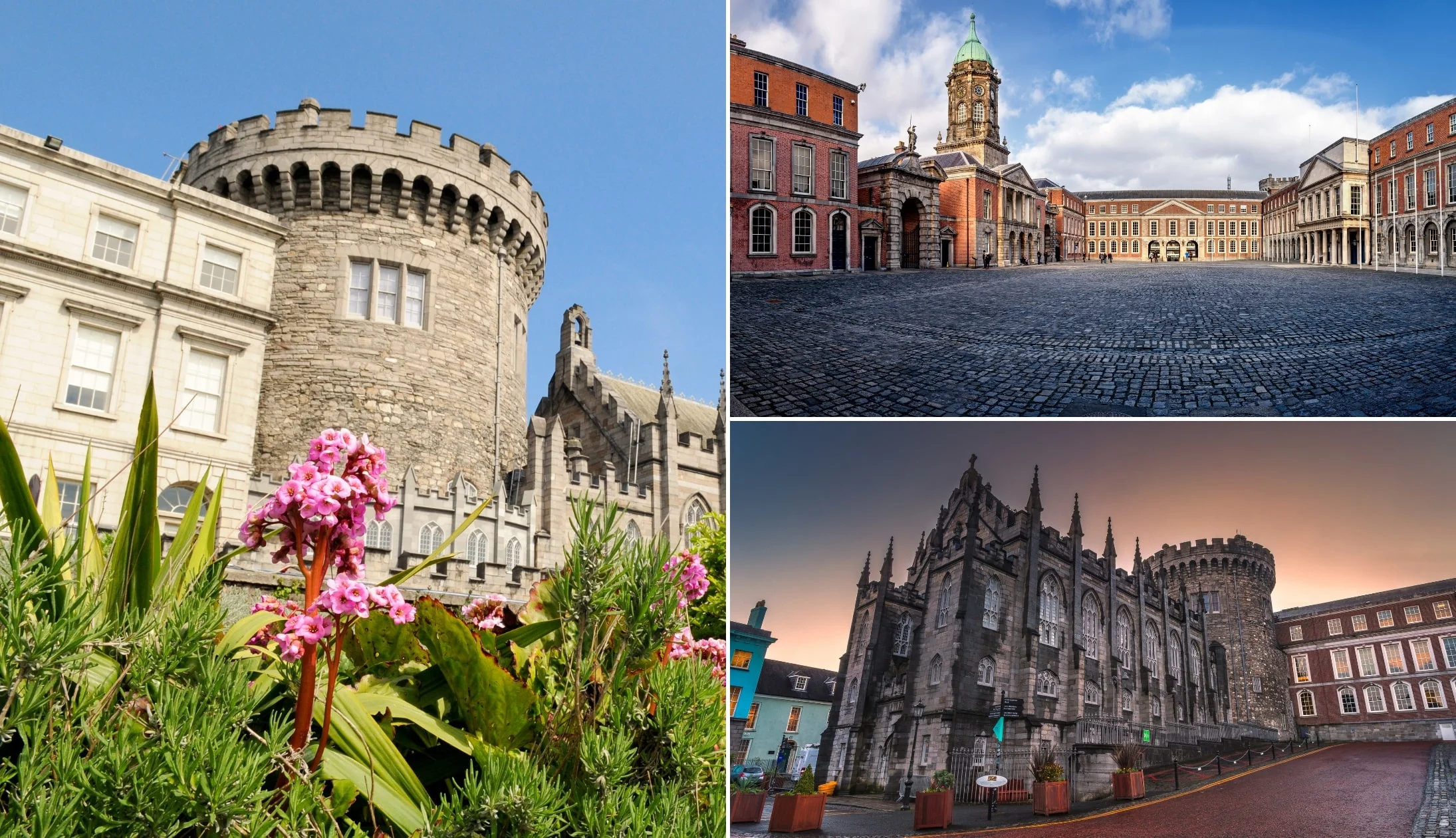
Photos via Shutterstock
Next on the itinerary is Dublin Castle. Nestled in the city centre, the castle dates back to the 13th century and was the seat of the English for over 700 years.
Today, it’s an important government complex and the site of Presidential Inaugurations and key State events. The castle is around 10 minutes from the Ha’penny Bridge on foot.
There’s no admission fee to explore the grounds, but if you want to have a look inside you’ll need to purchase tickets for either a self-guided tour or a guided tour.
Guided tours include access to the State Apartments, Exhibitions, Chapel Royal, and the Mediaeval Undercroft. Self-guided tours include access to the State Apartments and Exhibitions only.
Tickets for guided tours can be purchased on the day of your visit at the ticket booth.
Stop 5: Christ Church Cathedral
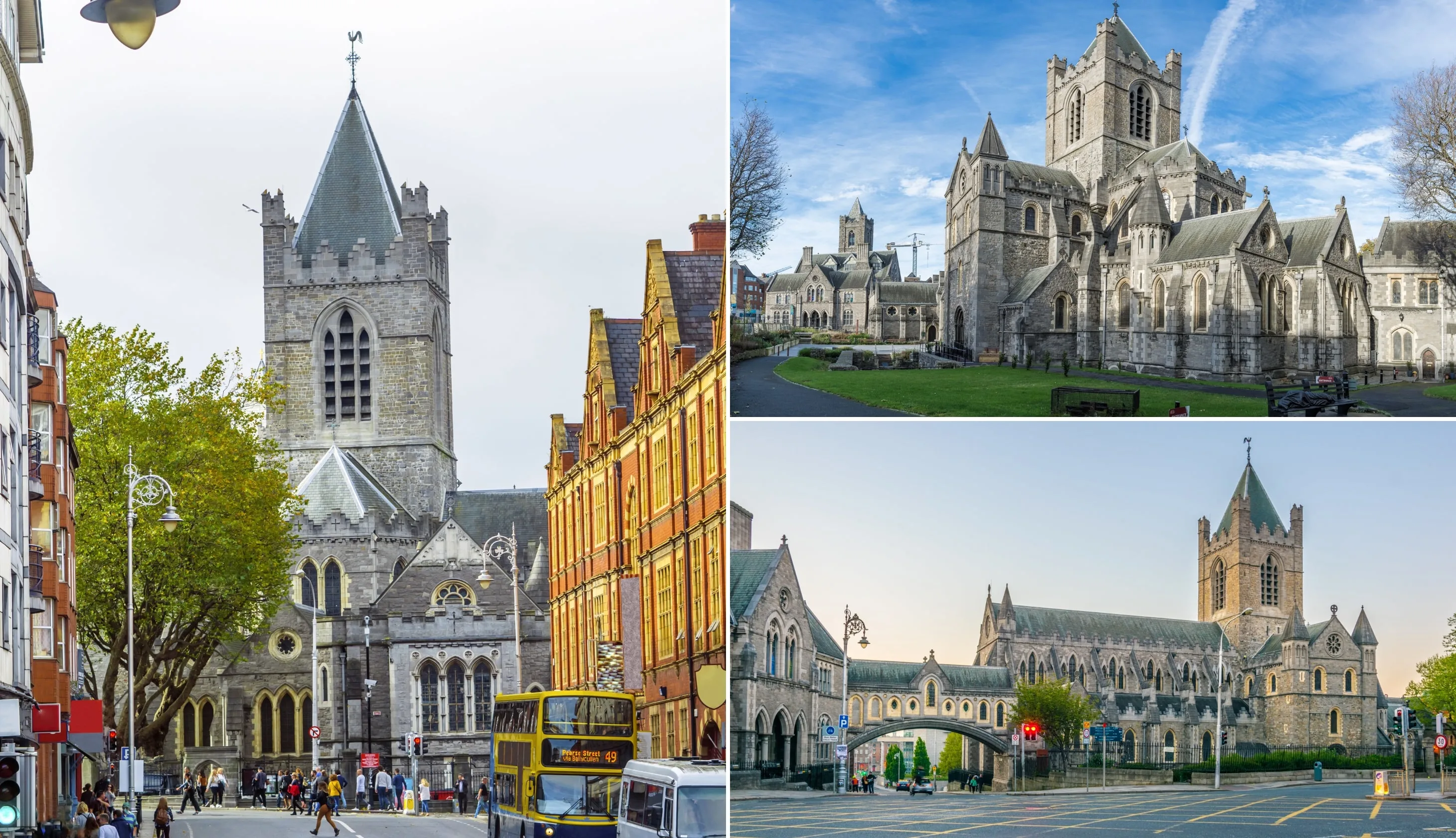
Photos via Shutterstock
Christ Church Cathedral dates back to the early 11th century when it was founded under Sigtrygg Silkbeard, a Norse King of Dublin. It was rebuilt later in stone, largely thanks to the first Anglo-Norman archbishop, John Cumin, in the late 12th century.
The cathedral is only a 4-minute walk from Dublin Castle and a really interesting place to visit. Some highlights are the restored crypt houses, Strongbow’s tomb, and the Treasures of Christ Church exhibition.
You can grab a ticket online here – these include an audio guide that comes in several languages, with three themes to choose from – ‘Power and Politics’, ‘Music and Spirituality’, and ‘Christ Church and the City’.
Self-guided tours with an audio guide usually last around one hour.
Stop 6: St. Patrick’s Cathedral

Photos via Shutterstock
St. Patrick’s Cathedral is just a short 7-minute walk from Christ Church Cathedral. The magnificent cathedral is one of the city’s top attractions as well as one of the few remnants of Medieval Dublin!
It dates back to the 12th century and is Ireland’s largest cathedral. As you may expect, St. Patrick’s Cathedral has a long and rich history. The cathedral has fallen into disrepair and has been damaged several times, most notably in the early 19th century.
During this period, it was restored by none other than Benjamin Lee Guinness (the first Lord Mayor of Dublin and owner of Guinness).
Stop 7: Teeling’s Distillery

Photos courtesy Teeling Whiskey Distillery via Failte Ireland
Once you’ve had your fill of St. Patrick’s, head on over to the Teeling Distillery, an 8-minute walk away. Founded by the Teeling family in 2015, the Teeling’s Distillery was the first new distillery to open in Dublin in over 125 years!
However, the family’s expertise span back generations, as they established a small craft distillery on Marrowbone Lane in 1782. Today, the new distillery stands just a few streets away from the family’s ancestral distillery.
They have several tours available, each of which has great reviews online. You can grab a ticket online before you go that includes a fully-guided tour of the distillery, followed by a tasting.
Stop 8: Dinner, drinks and live music
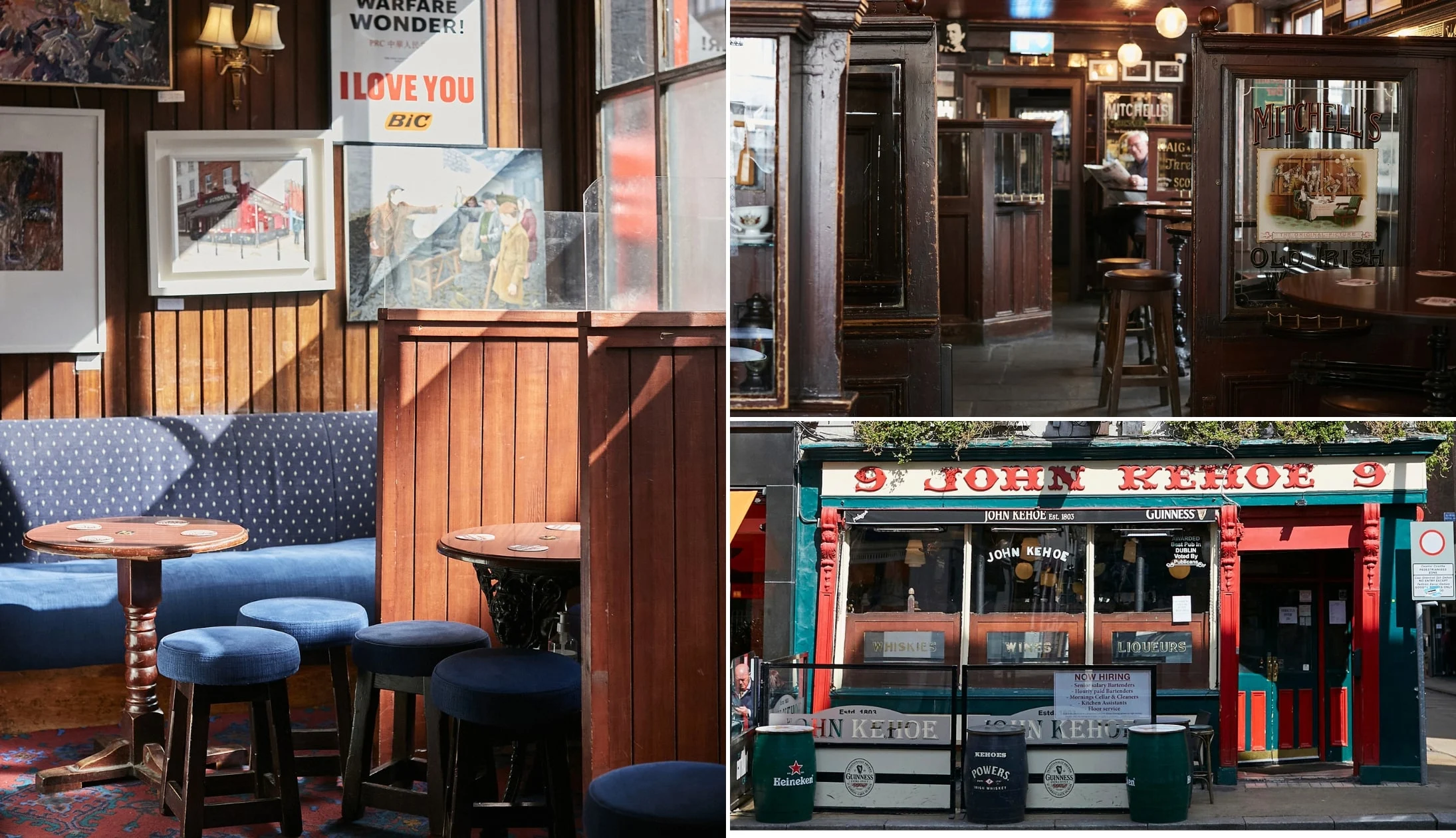
Different trad bars in Dublin. © Tourism Ireland
By now you must be getting hungry. Dublin has heaps of options for dinner, but we’ve got a couple of suggestions for you!
Our dinner recommendations
If you’re looking for something close by, Spitalfields is a stone’s throw from the Teeling’s Distillery. It’s a little bit pricey, but the atmosphere is great and the food is top-notch!
However, Spitalfields is 16+ only, so it’s not suitable for young families. Otherwise, check out The Bull and Castle across the street from Christ Church Cathedral.
Their menu has F.X. Buckley Steaks (renowned in Dublin), plus a great selection of local craft beers. The restaurant can get booked out pretty quickly, but you can always eat in the bar upstairs, which also has steak on the menu.
Live music and trad bars
If you want a taste of what Dublin’s best pubs are, see our detailed Dublin pubs guide. If you’re solely looking for places that do exceptional Guinness, see our guide to Dublin’s best pints.
If you fancy a bit of live music, there’s plenty on offer. Pipers Corner on Marlborough St. has some great tunes, with live music from 9pm every Tuesday to Saturday, and from 8pm on Sunday.
The inside has more of a modern feel, but you’ll be guaranteed authentic Irish music.
For the full experience, O’Donoghues Bar on Merrion Row has live music every night of the week. It’s about as traditional as Irish pubs get, with a brilliant atmosphere.
The Celt is another fantastic pub with live music every night from 9pm, although it’s not always traditional.
Day 2: More Dublin City sites

Photos via Shutterstock
It’s day 2 of our 6 days in Ireland itinerary, and there’s a full day of Dublin sightseeing ahead of you.
Now, although we’ve focused on the city for day two of this itinerary, you could easily change this day and explore the coast of Dublin.
For example, you could take a spin out to Howth Village, tackle the Howth Cliff Walk, grab lunch in the village and then take the train over to Malahide Castle.
Or, you can take it easy and stick to the city, like we do in the itinerary below.
Stop 1: Breakfast
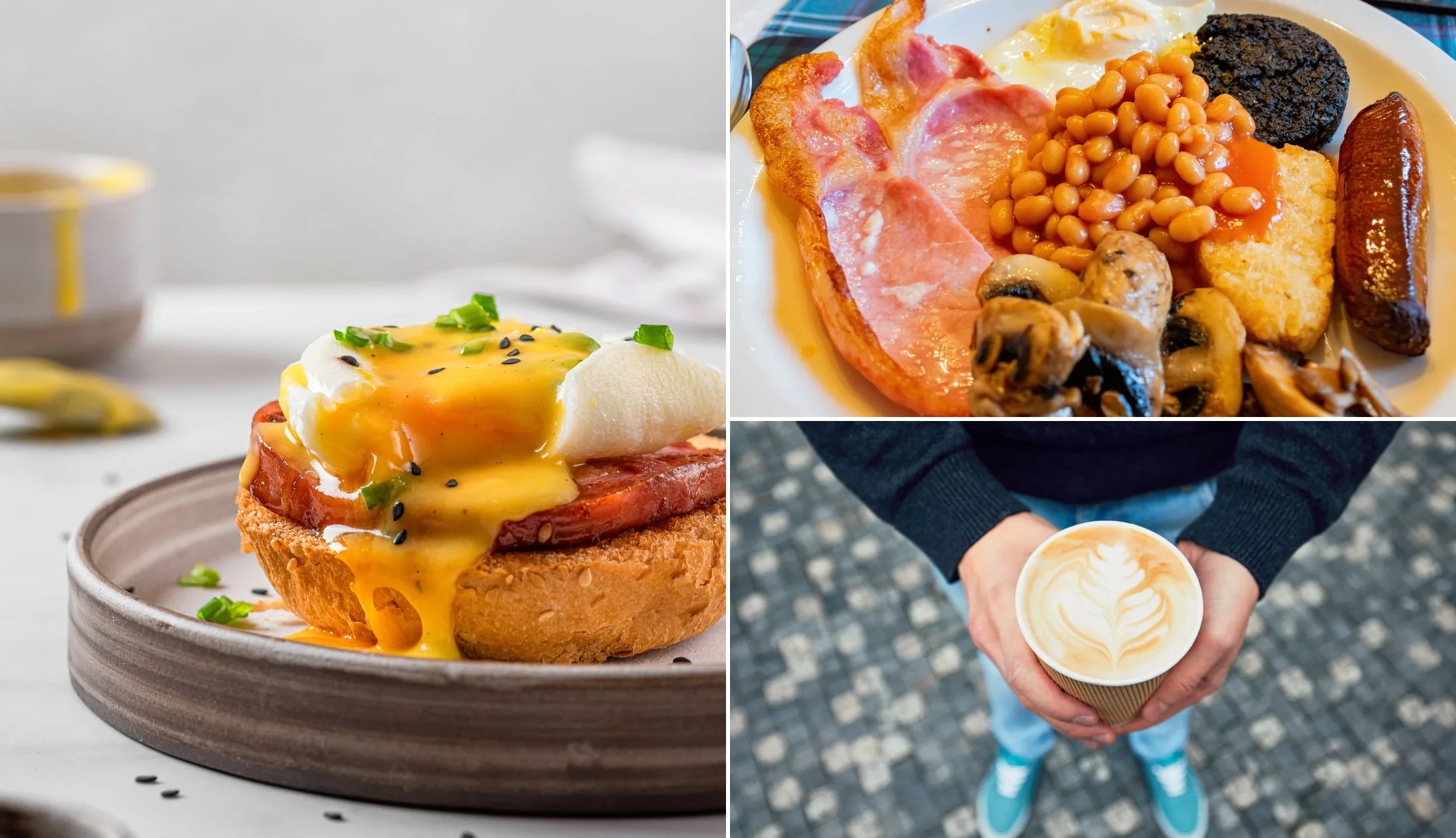
Photos via Shutterstock
It’s time for day 2, so grab some breakfast at your accommodation or grab a quick bite from a nearby cafe.
We recommend stopping by Cool Hand Coffee Roasters on Emmet Road. They’re a short 3-minute stroll from our next stop (Kilmainham Gaol), serving speciality coffees and a selection of pastries.
Stop 2: Kilmainham Gaol

Photos via Shutterstock
Kilmainham Gaol is an extremely popular Dublin attraction so you’ll need to buy tickets in advance as they tend to sell out quickly.
We recommend allowing an extra 30 minutes before/after your tour so you can visit the museum.
The gaol has a history spanning over 100 years, and during its time, it housed prisoners from the 1798 rebellion, the Anglo-Irish War, and the Irish Civil War.
Visitors will have an interesting insight into what imprisonment was like in the gaol, and the role it played in Irish history.
We’d recommend making your own way here via the Luas Red line from the city centre. You can get off at Heuston Station and take the 15-to-20-minute walk to Kilmainham Gaol.
Stop 3: Irish Museum of Modern Art

Photos via Shutterstock
Make your way to the Irish Museum of Modern Art (IMMA), a 10-minute walk away from Kilmainham Gaol. The museum is housed in the beautiful 17th-century Royal Hospital Kilmainham, tucked away on 48 acres of grounds.
The IMMA has a wide variety of exhibitions showcasing 3,500 modern and contemporary art pieces by local and international artists.
It’s free to visit (although some exhibitions may charge a small fee), and throughout the week there are free 30-minute tours – please check their website for up-to-date tour times.
If you’ve got the time (and the weather is in your favour), take a quick turn around the grounds to check out more artworks and the Formal Gardens.
Stop 4: St. Michan’s

Photos with thanks to Jennifer Boyer
St. Michan’s is a 25-minute walk away from IMMA, but if you’re feeling tired, you can head to Heuston Station and jump on the Luas towards Saggart.
Get off at Smithfield which is a stone’s throw from St. Michan’s and close to the Brazen Head, our recommendation for lunch! All in all, this takes 15 minutes.
St. Michan’s is an incredibly interesting church that dates back to 1686, although there used to be a Christian chapel on the same spot which was established as early as 1095.
Despite its modest size, St. Michan’s is packed full of history. In our opinion, the best way to learn about it is on their guided tour, which gives you loads of interesting info.
During the tour, you’ll get the chance to go into the 12th-century crypts and see real-life mummies that have been preserved for over 500 years; head into the vaults which were frequented by famous author Bram Stoker; and the magnificent organ which is one of the oldest still in use in Ireland.
Stop 5: Lunch
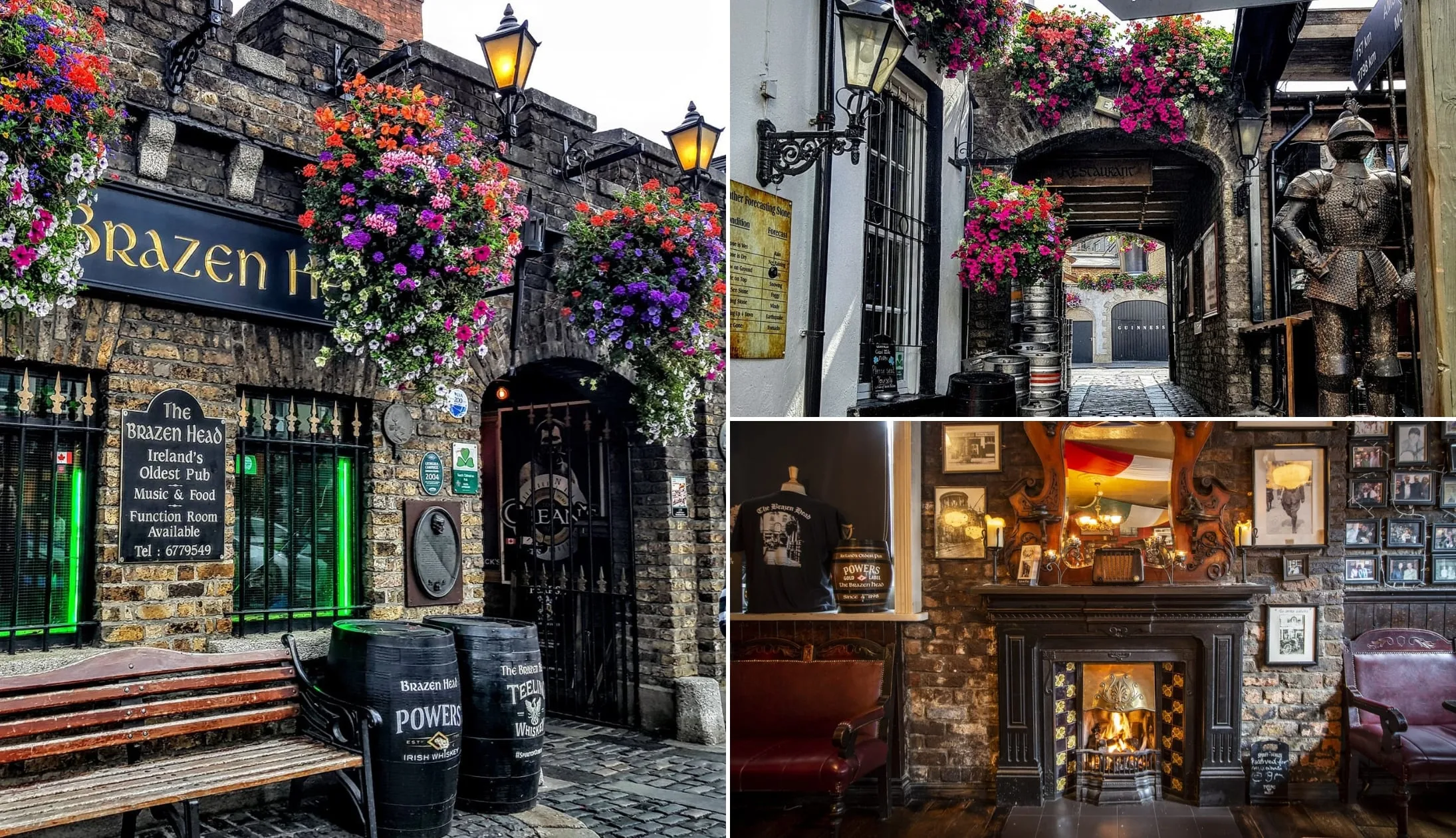
Photos via Shutterstock
There’s some very old pubs in Dublin, but one reigns supreme! When you finish up at St. Michan’s short 7-minute walk to the Brazen Head.
The pub is the oldest in Dublin and one of the oldest in Ireland, dating back to 1198. They serve traditional Irish pub grub and their Guinness beef stew is divine.
You’ve had a busy morning so kick back here, make your belly happy and set yourself up for the next stop of the day.
Stop 6: Guinness Storehouse

Photos © Diageo via Ireland’s Content Pool
Walk off your hearty pub lunch by taking the short 14-minute stroll to the Guinness Storehouse. It’s at St. James’s Gate, the home of Guinness, and there are several tours available.
We recommend the Guinness Storehouse Experience, a self-guided tour that takes roughly 90 minutes.
You’ll learn about Guinness’ history, its ingredients, and get to enjoy a pint of Guinness and one other Guinness beer (for ages 18+) whilst taking in the views of the Gravity Bar.
Stop 7: St. Audoen’s Church

Photos via Shutterstock
St. Audoen’s Church is a 14-minute walk from the Guinness Storehouse. While it’s well worth a visit, you won’t need too much time here.
The church dates back to 1190, making it the oldest Parish church in the city. However, parts of the church were added/restored at a later date, including the tower, which was damaged in 1596 following a huge gunpowder explosion nearby.
When you stop by, make sure to head to the main porch to have a look at the “Lucky Stone”, a late 9th-century gravestone that traders and merchants used to rub for good luck!
Stop 8: Dinner, drinks and live music

Different trad bars in Dublin. © Tourism Ireland
For your second night in Dublin, we’ve got a few recommendations for you to consider.
Our dinner recommendations
If you’re looking for something close by, Spitalfields is a short walk from the cathedral. It’s a little bit pricey, but the atmosphere is great and the food is top-notch!
However, Spitalfields is 16+ only, so it’s not suitable for young families. Otherwise, check out The Bull and Castle across the street from Christ Church Cathedral.
Their menu has F.X. Buckley Steaks (renowned in Dublin), plus a great selection of local craft beers. The restaurant can get booked out pretty quickly, but you can always eat in the bar upstairs, which also has steak on the menu.
Live music and trad bars
If you want a taste of what Dublin’s best pubs are, see our detailed Dublin pubs guide. If you’re solely looking for places that do exceptional Guinness, see our guide to Dublin’s best pints.
If you fancy a bit of live music, there’s plenty on offer. Pipers Corner on Marlborough St. has some great tunes, with live music from 9pm every Tuesday to Saturday, and from 8pm on Sunday.
The inside has more of a modern feel, but you’ll be guaranteed authentic Irish music.
For the full experience, O’Donoghues Bar on Merrion Row has live music every night of the week. It’s about as traditional as Irish pubs get, with a brilliant atmosphere.
The Celt is another fantastic pub with live music every night from 9pm, although it’s not always traditional.
Day 3: Wicklow’s Wonders
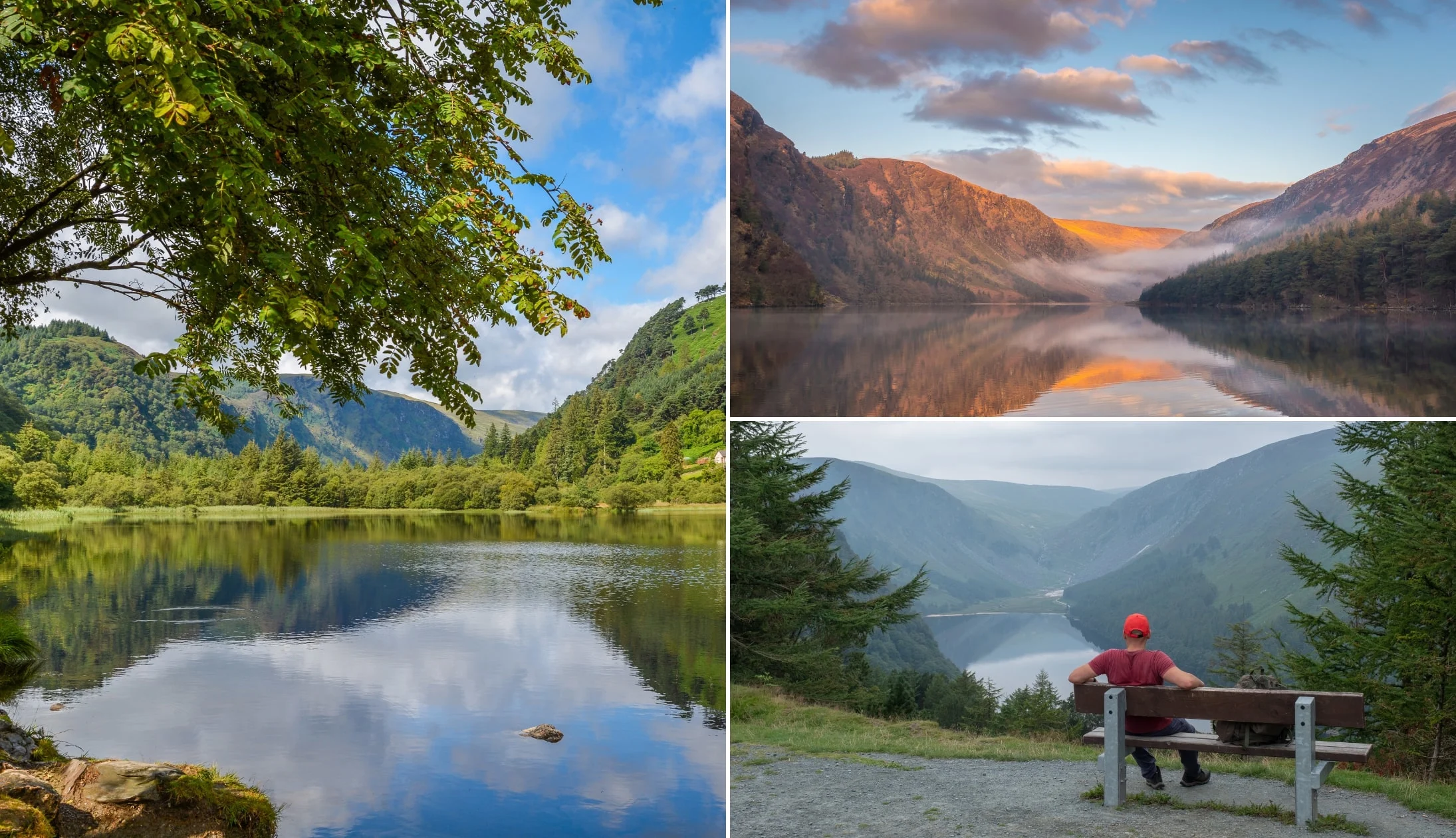
Photos via Shutterstock
On day 3 of your 6 days in Ireland itinerary, it’s time to put that rental car to use and head out of Dublin.
Today, you’ll be exploring Wicklow, also known as the Garden of Ireland.
Get yourself some breakfast either where you’re staying or at a cafe nearby. Then, double-check there’s a good amount of fuel in the car before heading to beautiful Wicklow via Sally Gap.
Stop 1: The Sally Gap Drive (multiple stops)
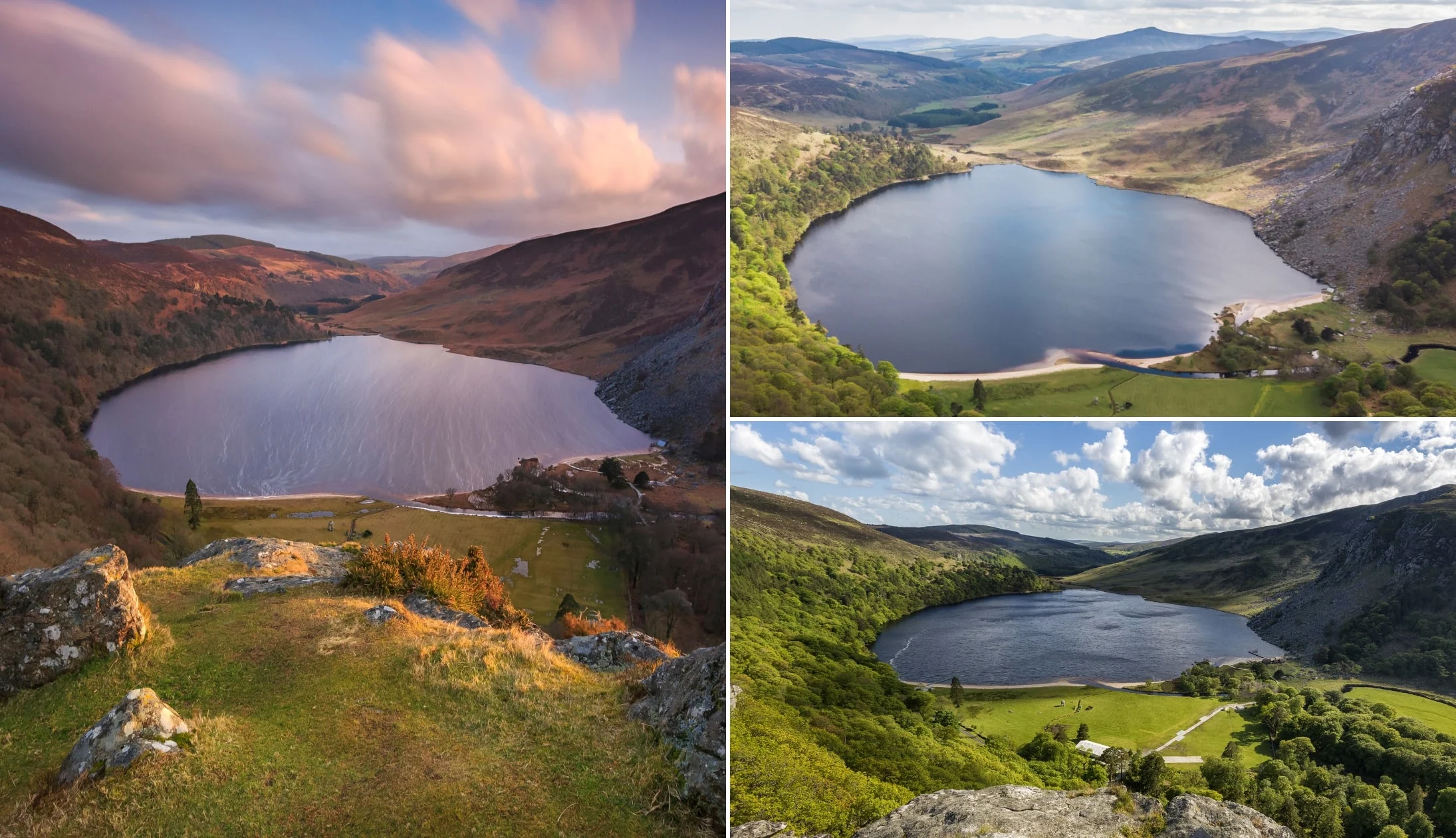
Photos via Shutterstock
The glorious Sally Gap Drive can’t be missed and you’re best off doing it either before you head to Glendalough, if you’re up early, or after, on your way home.
The reason for this is that you’re best off getting to Glendalough as early as you can, as it tends to get very busy at times.
When you do get to do the drive, aim for Lough Tay, first. Also known as Guinness Lake, Lough Tay is the jewel in Sally Gap’s crown!
From here, follow the winding road down, over the PS I Love You bridge and around until you reach a car park (on your right).
From here, very carefully walk around and get an eyeful of Glenmacnass Waterfall before heading on to Glendalough.
If you’re feeling up for a walk, we’ve got two for you to choose from. There’s the Djouce Mountain Walk and the Ballinastoe Woods Walk, both of which range from 2 to 2.5 hours in length.
Stop 2: Glendalough Visitor Centre and Monastic City
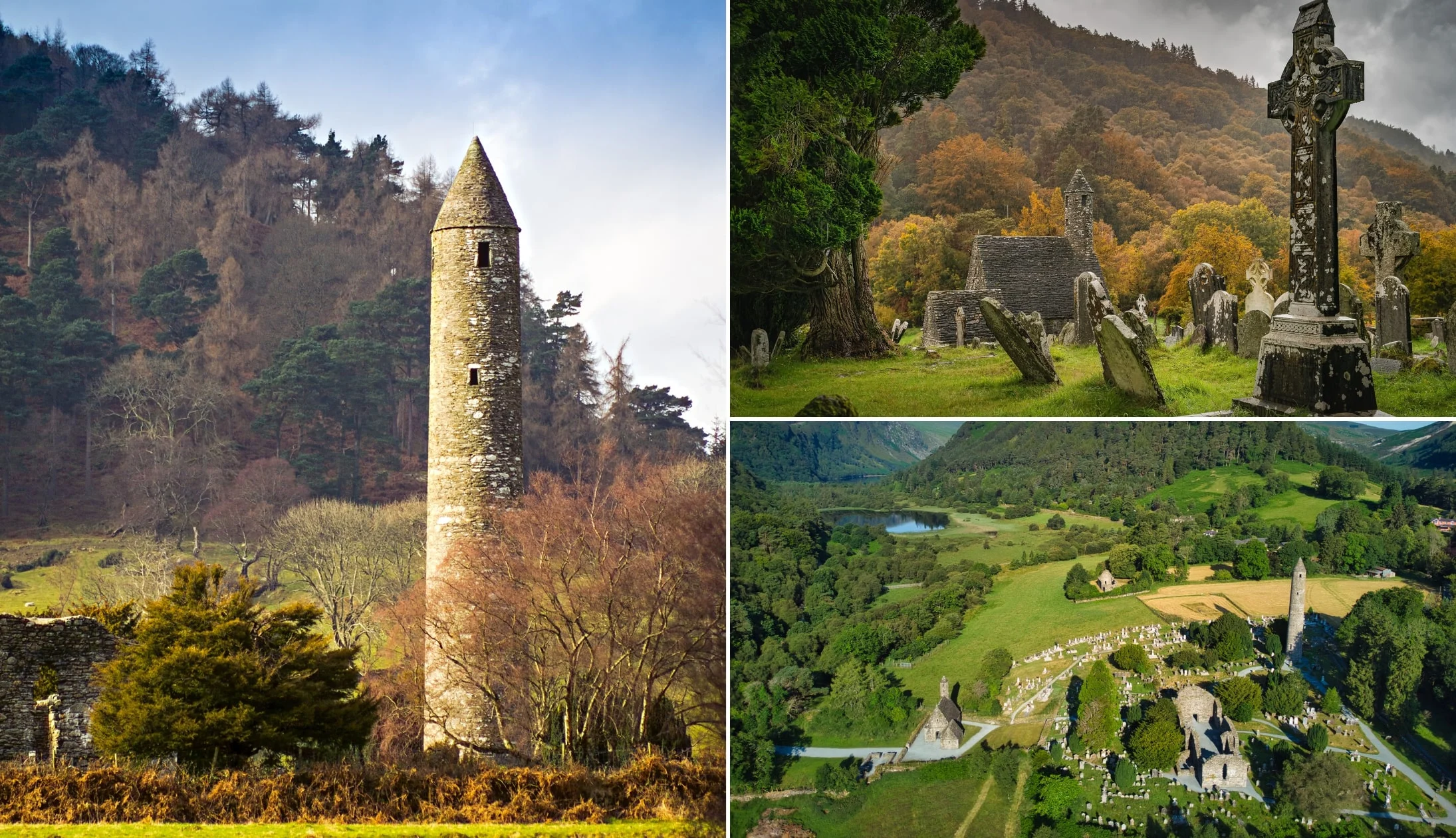
Photos via Shutterstock
Park up at the Glendalough Visitor Centre (the Lower Car Park – €4) and plan to spend between one and 30 – 45 minutes exploring the centre and the ‘Monastic City’ (your next stop).
The visitor centre is right next to the Monastic City, one of the most important monastic sites in the country. The city was founded by St. Kevin in the 6th century and went on to become one of Europe’s most famous religious sites!
At the centre, there’s a wonderful exhibition on the history of Glendalough and St. Kevin. There’s also an interesting 15-minute long audio and visual presentation about early Irish Saints and monasteries.
Now you’ve learned about the site, it’s time to take a 2-minute stroll to the Monastic City next door. Whilst the remains of the city are scattered all across the glen, many of the main ruins and features are within walking distance of the visitor centre.
These include the Glendalough Round Tower, one of the city’s most well-known landmarks. It stands 33 metres high and dates back almost 1000 years! Other attractions nearby include St. Kevin’s Church and the Glendalough Cathedral ruins.
Stop 3: The Spinc Walk
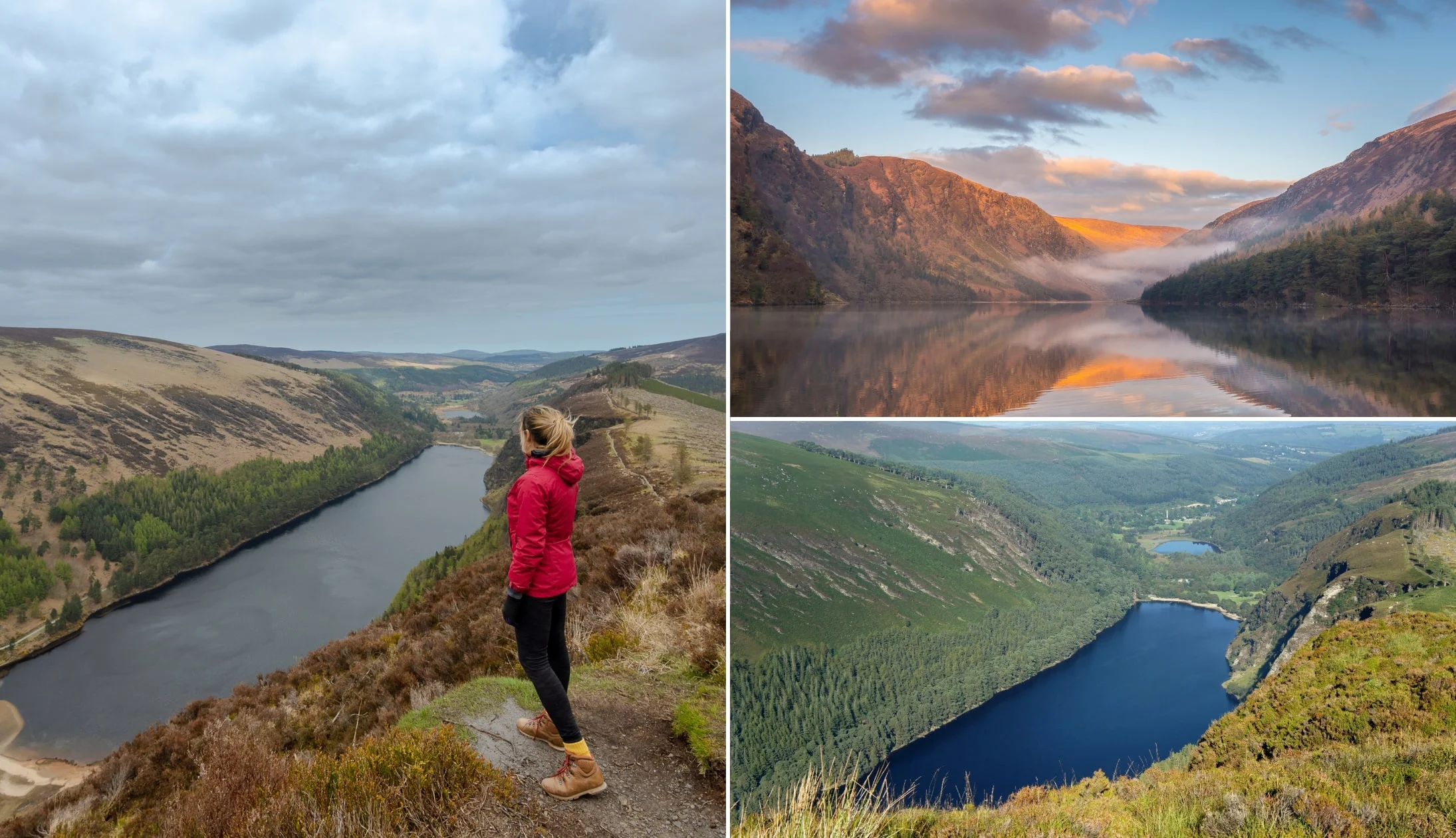
Photos via Shutterstock
The Spinc Walk is one of the finest trails in Glendalough. The Spinc Loop takes you on a 9.5 km ramble with some steep inclines and tricky paths.
There’s some steep climbing and over 600 steps near the start, but after that, it’s a little more relaxed, though there are some tricky downhill sections later.
It’s a moderate to strenuous walk, with a total ascent of 380 metres. Having said that, if you’re in reasonable shape, you should be okay and most people complete the walk in just over 3 hours.
Stop 4: Lunch at the Wicklow Heather

Photo left: The Irish Road Trip. Others: Via Wicklow Heather
We absolutely love stopping by the Wicklow Heather for lunch whenever we’re in Glendalough. The restaurant is in the heart of idyllic Laragh, with a historical interior and some lovely outdoor seating areas.
It’s only a 6-minute drive from the Upper Lake Car Park.
The menu has traditional Irish dishes, like comforting seafood chowder or hearty cottage pies, with an option for vegetarians and vegans.
Stop 5: Powerscourt Waterfall

Photos via Shutterstock
From the Wicklow Heather, Powerscourt Waterfall is around a 30-minute drive away. The waterfall stands 121 metres high, making it the tallest waterfall in Ireland! It’s a beautiful spot, with the water cascading down the rock face, surrounded by trees.
At the waterfall, you’ll find a dedicated car park, toilets, and in the summer, a refreshment kiosk selling drinks and snacks.
There’s a lovely walking route that takes around 30 minutes to complete, giving walkers nice views of the falls and surrounding parkland.
There are some small inclines, so make sure to put on some appropriate footwear.
Stop 6: Bray Seaside Stroll

Photos via Shutterstock
Hop in the car and drive 17 minutes towards Bray. The best place to park is at the Bray Council Car Park here. It’s right above the beach, so it’s just a short stroll to the sand.
Bray Beach is a sandy and shingle beach over 1.6km long. You can walk along the sand or along the promenade towards Bray Head and back.
Stop 7: Back to Dublin for the night

Different trad bars in Dublin. © Tourism Ireland
After a long (and hopefully enjoyable!) day of exploring, it’s time to say goodbye to Wicklow and head back to Dublin.
If you’re already feeling a little hungry, break up the journey by stopping at Johnnie Foxes for dinner. It’s a lively traditional pub serving up hearty Irish food and great pints.
They run a daily ‘Hooley Show’ with Irish dancing and music. You can buy tickets (which include a four-course dinner) on their website.
Johnnie Foxes is 15 minutes from Powerscourt House and another 40 minutes to Dublin, depending on traffic.
Or, if you head straight back to Dublin, here are some food and pub recommendations for you.
Our dinner recommendations
If you’re looking for something close by, Spitalfields is a short walk from the cathedral. It’s a little bit pricey, but the atmosphere is great and the food is top-notch!
However, Spitalfields is 16+ only, so it’s not suitable for young families. Otherwise, check out The Bull and Castle across the street from Christ Church Cathedral.
Their menu has F.X. Buckley Steaks (renowned in Dublin), plus a great selection of local craft beers. The restaurant can get booked out pretty quickly, but you can always eat in the bar upstairs, which also has steak on the menu.
Live music and trad bars
If you want a taste of what Dublin’s best pubs are, see our detailed Dublin pubs guide. If you’re solely looking for places that do exceptional Guinness, see our guide to Dublin’s best pints.
If you fancy a bit of live music, there’s plenty on offer. Pipers Corner on Marlborough St. has some great tunes, with live music from 9pm every Tuesday to Saturday, and from 8pm on Sunday.
The inside has more of a modern feel, but you’ll be guaranteed authentic Irish music.
For the full experience, O’Donoghues Bar on Merrion Row has live music every night of the week. It’s about as traditional as Irish pubs get, with a brilliant atmosphere.
The Celt is another fantastic pub with live music every night from 9pm, although it’s not always traditional.
Day 4: The Drive to Galway (Via Athlone)

Photos by Stephen Power via Ireland’s Content Pool
On day 4 of our 6 days in Ireland itinerary, it’s time to say goodbye to Dublin and head over to beautiful Galway.
The drive usually takes around two and a half hours, but you’ll be stopping in historic Athlone to break up the journey and do some sightseeing.
We’ve got a few recommendations on where to stay in Galway. They’re all in the heart of the city, with different options to suit your budget!
Recommended accommodation in Galway
- Budget: Feeney’s Audubon Lodge (in Salthill outside of the city by the sea) and Corrib View Guesthouse (a 45-minute walk from Eyre Square)
- Mid-range: Balcony House B&B (10-minute walk from Eyre Square) and Ash Grove House (gorgeous guesthouse near Galway Cathedral)
- Luxury: The G Hotel (luxury hotel in the city) and Glenlo Abbey (one of Ireland’s top hotels – 15-minute drive from the city)
Stop 1: Athlone Castle
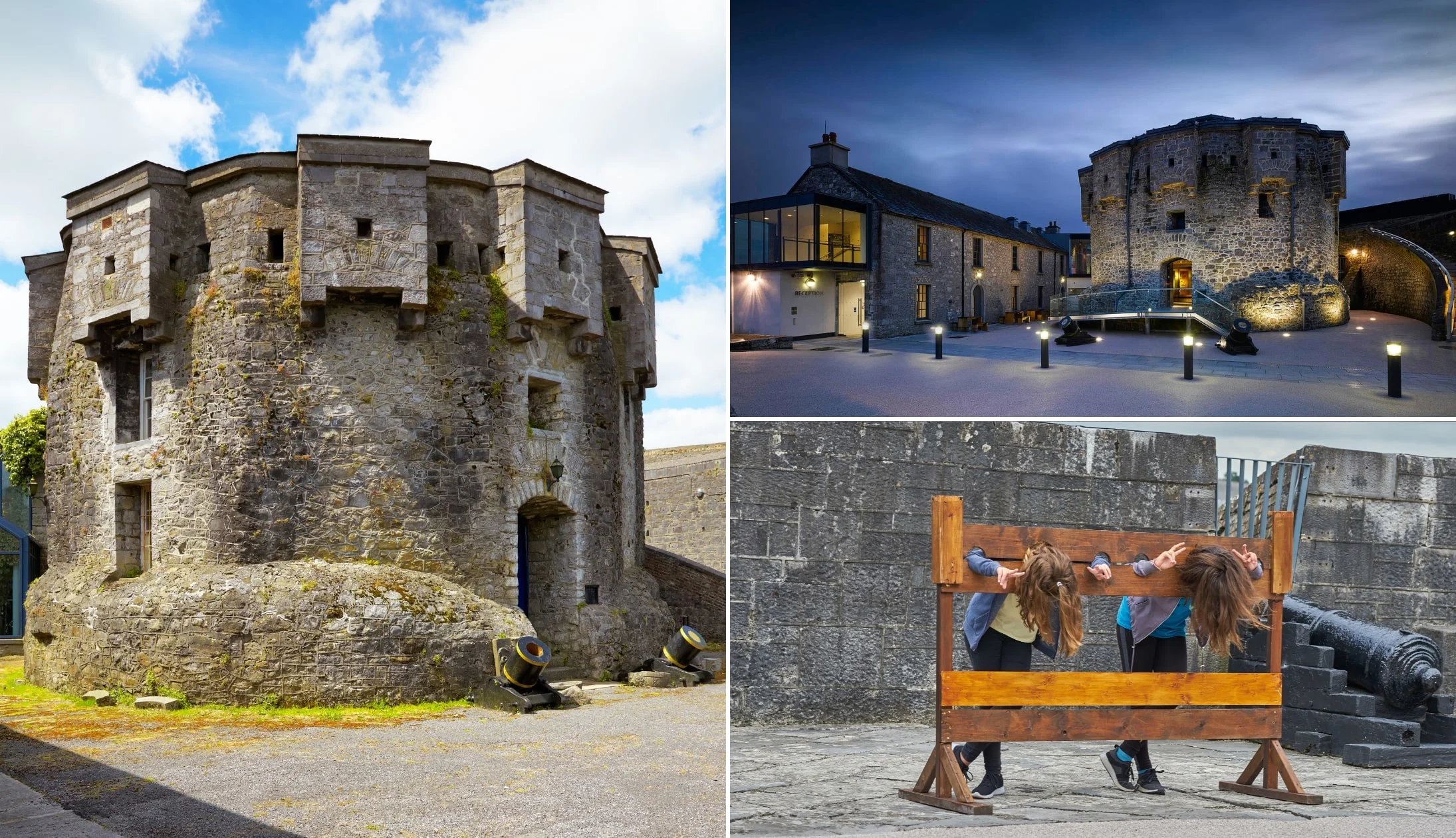
Top right photo: Ros Kavanagh via Failte Ireland. Others: Shutterstock
Athlone Castle is in the centre of Athlone on the banks of the River Shannon. There are two public car parks around the castle, as well as plenty of street parking if these get full (see parking here and here on Google Maps).
The stone castle is in great condition and dates back to the 13th century. It was in a key strategic position for defending the Athlone river crossing and played an important part in the infamous Siege of Athlone.
The visitor centre is full of information about the castle’s history, with eight exhibitions.
Stop 2: Sean’s Bar
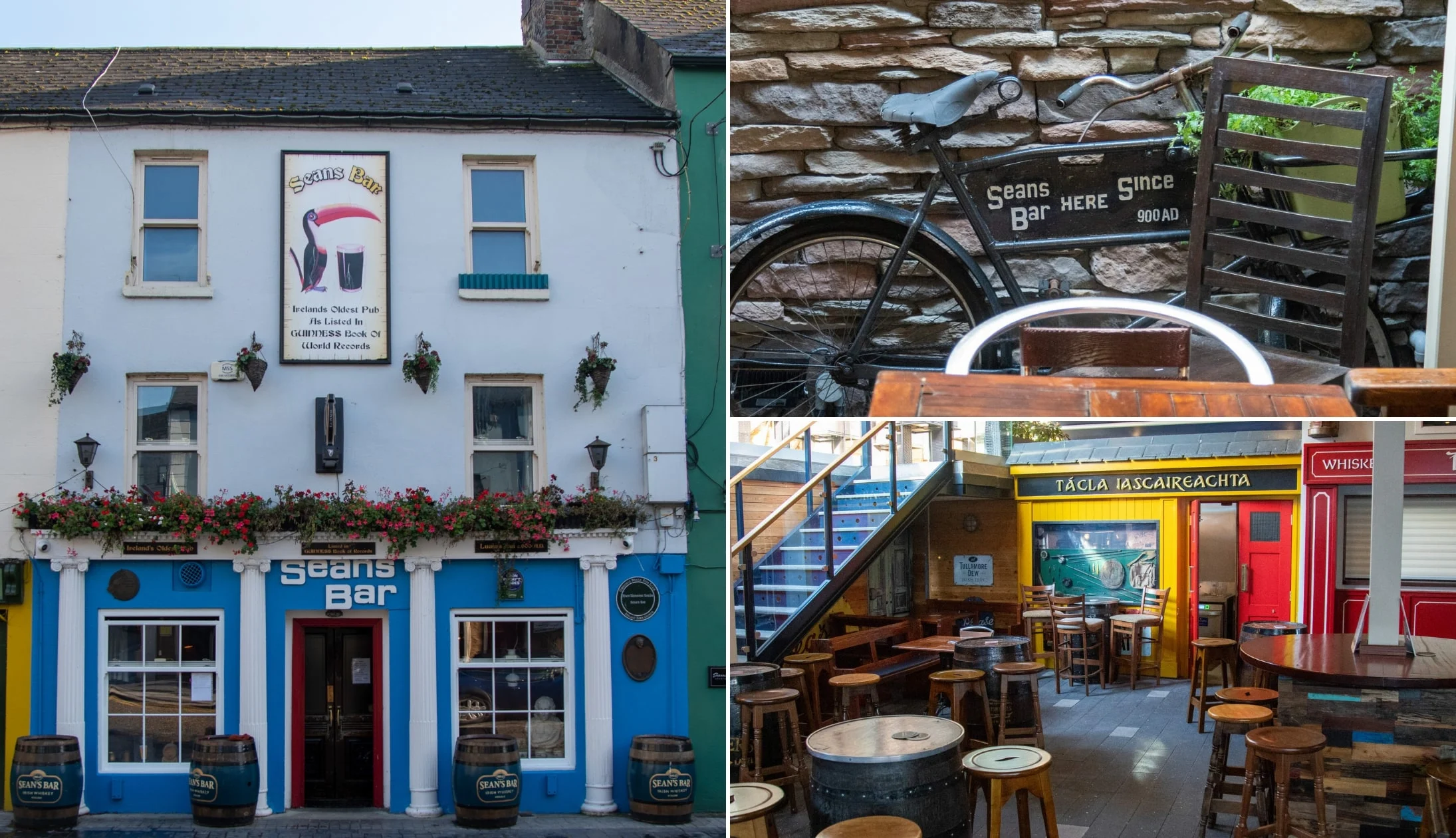
Photos courtesy Sonder Visuals via Ireland’s Content Pool
Sean’s Bar is right next to the castle and just a one-minute walk away. The pub is a must-visit when in Athlone, as it’s officially recognised by the Guinness Book of World Records as the oldest pub in Ireland (and possibly the world!).
It dates back to 900 AD when it was opened by a man named Luain Mac Luighdeach. Inside, it’s a treasure trove of history, plus, they serve a fantastic pint of Guinness.
Stop 3: Lunch

Photos via Beans & Leaves on FB
By now, you must be hungry, so it’s time to find somewhere for a bite to eat. Our favourite places for lunch in Athlone are The Left Bank Bistro (modern Mediterranean and Asian) and Beans and Leaves (all-day-breakfast and Irish cuisine).
However, the Corner House Bistro (gourmet sandwiches and international cuisine) is also well worth considering.
Stop 4: Check-in, get lunch and decide between walking/the bus
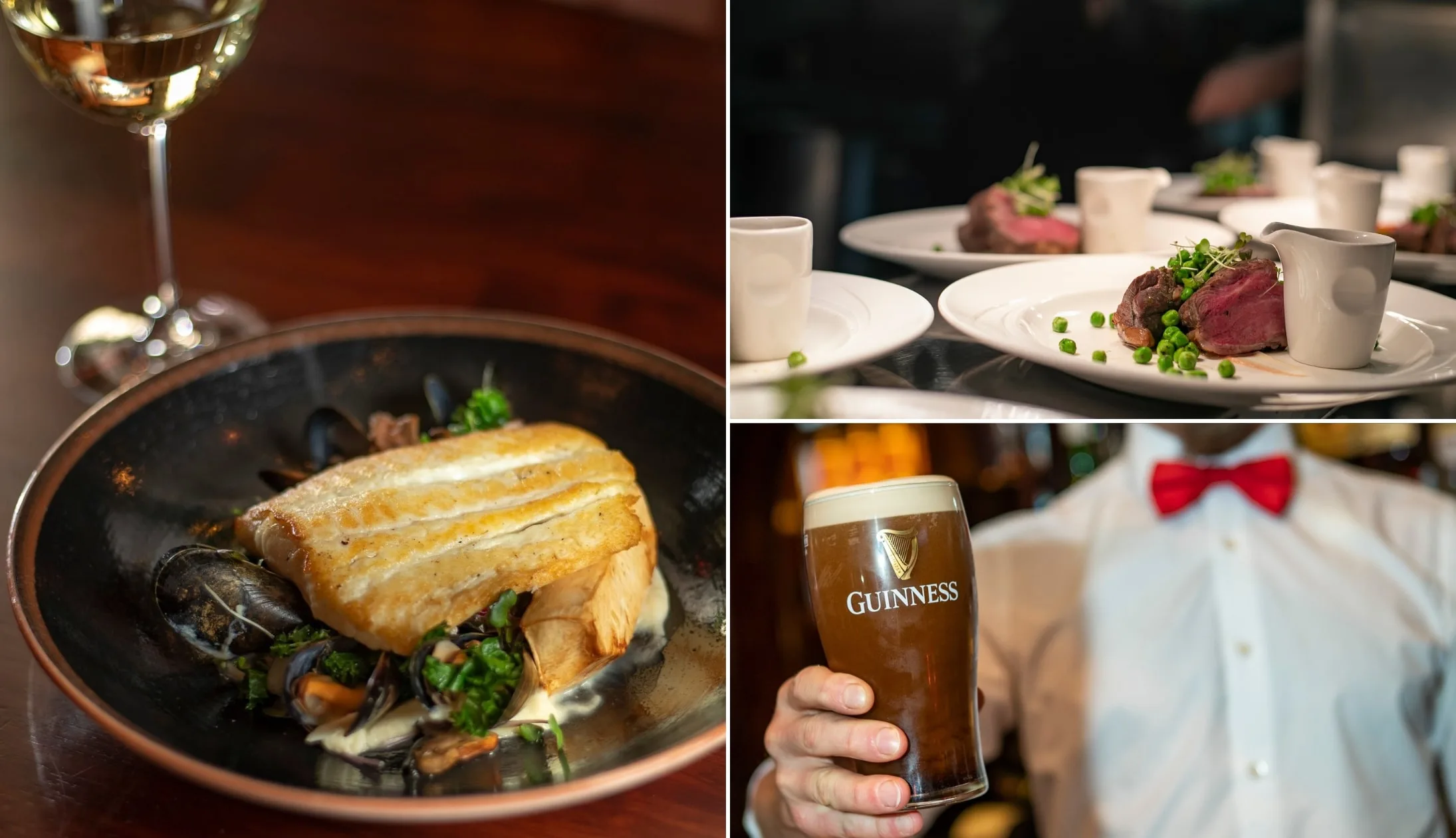
Photos via Blakes Bar Galway on FB
When you land in Galway, head to your accommodation, get checked in and head for lunch.
By now, you must be hungry. There are heaps of brilliant places for lunch in Galway, but if you don’t want the hassle of finding somewhere to eat, we’ve got a few suggestions!
We recommend Blakes Bar (traditional pub grub), Zappis (authentic Italian cuisine), or Tigh Neachtain (Irish and international cuisine).
Now, Galway is a very walkable city, but if it’s raining or if you fancy getting dropped to the ‘main’ attractions the hop-on/hop-off bus tour is well worth buying.
Regardless of which option you choose, here are some of our favourite sites in Galway City (we’ve listed them in a logical way for you to walk between them).
Stop 5: Galway Cathedral

Photos via Shutterstock
Galway Cathedral is wonderfully impressive both inside and out. It’s arguably the jewel in the Galway City skyline and you’ll cop it from many places as you stroll around the city.
Interestingly enough, it’s not as old as it looks, and construction on the building was only completed in 1965, earning it the title of ‘the last great stone cathedral to be constructed in Europe’.
The cathedral is free to enter but visitors are asked for a donation of €2 to help with the building’s upkeep.
Stop 6: Quay Street and the Latin Quarter

Photos by Stephen Power via Ireland’s Content Pool
Galway’s colourful streets are an absolute joy the ramble along regardless of the time of year.
If you’re walking from the cathedral, you’re a short stroll away from the Latin Quarter and Quay Street where you can have a nosey around.
These streets are alive with the buzz from tourists and locals alike.
Stop 7: The Hall of the Red Earl

One of our favourite places to visit in Galway (especially if it’s raining!) is the Hall of the Red Earl.
The Hall of the Red Earl is one of Galway’s most interesting sites. The ruins date back to the 13th century, with ties to the founding of Galway and the Anglo-Norman De Burgo family.
It was the first municipal building in the city, used for collecting taxes, hosting banquets, and sentencing criminals.
The Hall of the Red Earl was lost as the city grew until 1997, when the ruins were unearthed by archaeologists on behalf of the Office of the Public Works.
Today, you can walk amongst the ruins, view the artefacts, and learn about the hall’s history from the informative displays.
Stop 8: Galway City Museum
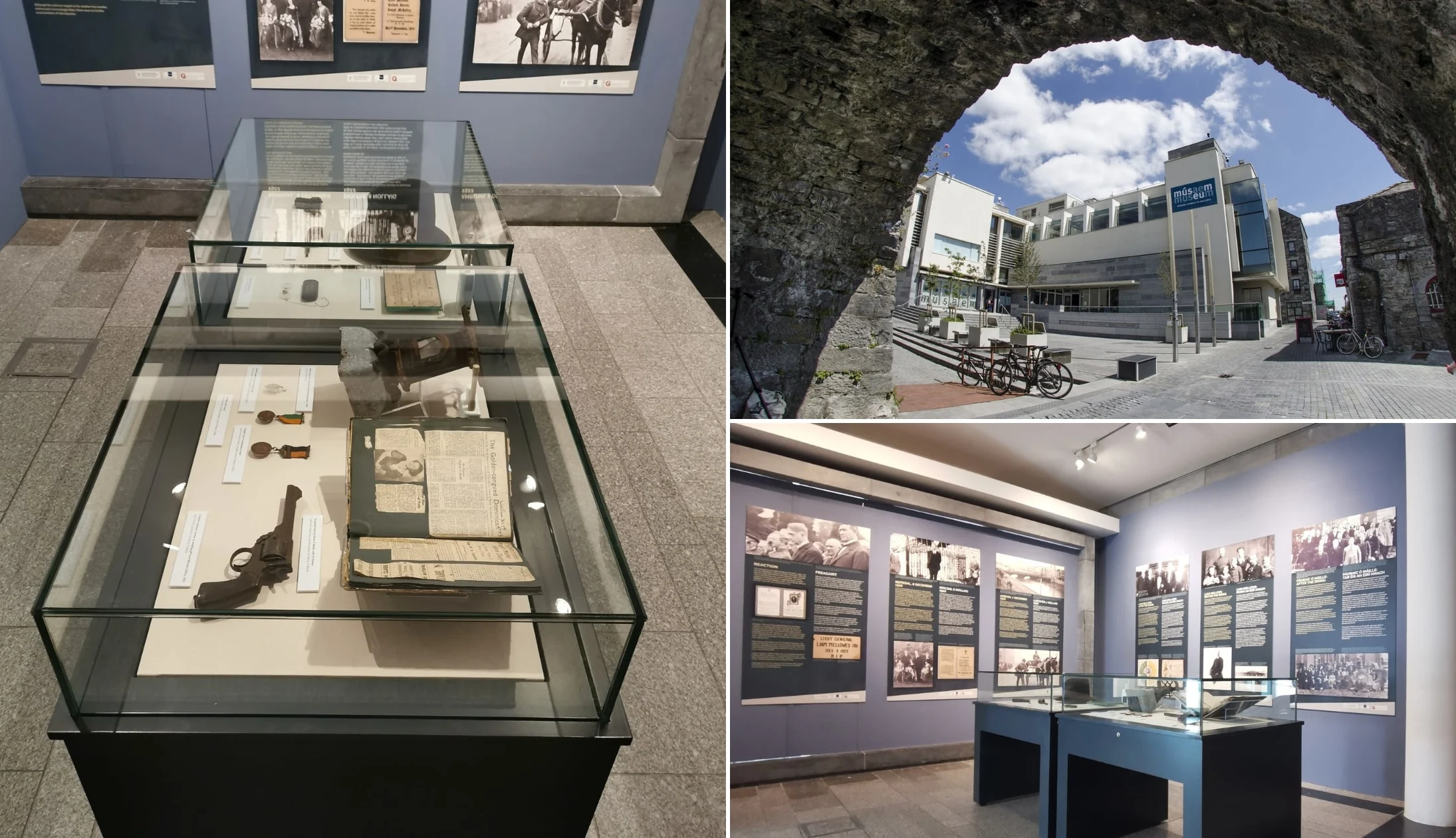
Photos via Galway City Museum on FB
The Galway City Museum is just a stone’s throw from the Spanish Arch. It’s one of the best places to learn about Galway’s history, culture, and archaeology, with collections telling the story of prehistoric Galway all the way through to 19th and 20th-century Galway!
The museum has three floors and seven long-term exhibitions, including The Wild Atlantic – Sea Science, and an exhibition on Pádraic Ó Conaire.
It’s free to visit, although donations are always appreciated.
Stop 9: Spanish Arch and the Long Walk
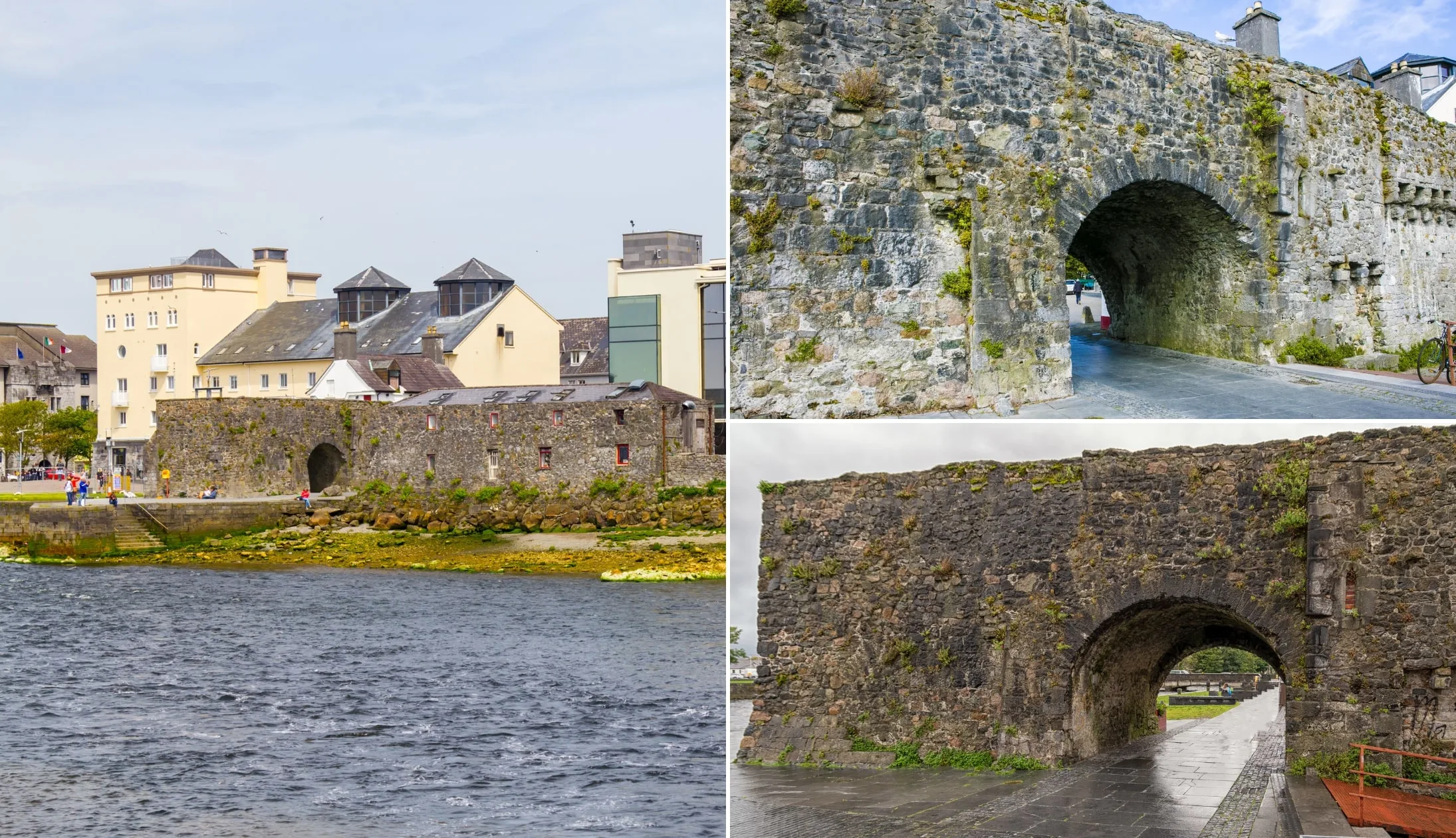
Photos via Shutterstock
The Spanish Arch is a must-see Galway attraction, dating back to Medieval times. The large stone arch is located on the outskirts of the city centre, overlooking the Claddagh (shore).
It originally housed soldiers who were keeping watch on the city’s Medieval walls. Its nickname is thought to come from the city’s merchant trade with the Spanish, whose ships would often be docked in the area!
From the Spanish Arch, you can take a short stroll alongside the water to what’s known as The Long Walk. You’ll likely have seen pictures of it (it’s a line of colourful buildings right on the water).
Stop 10: Dinner, drinks and live music
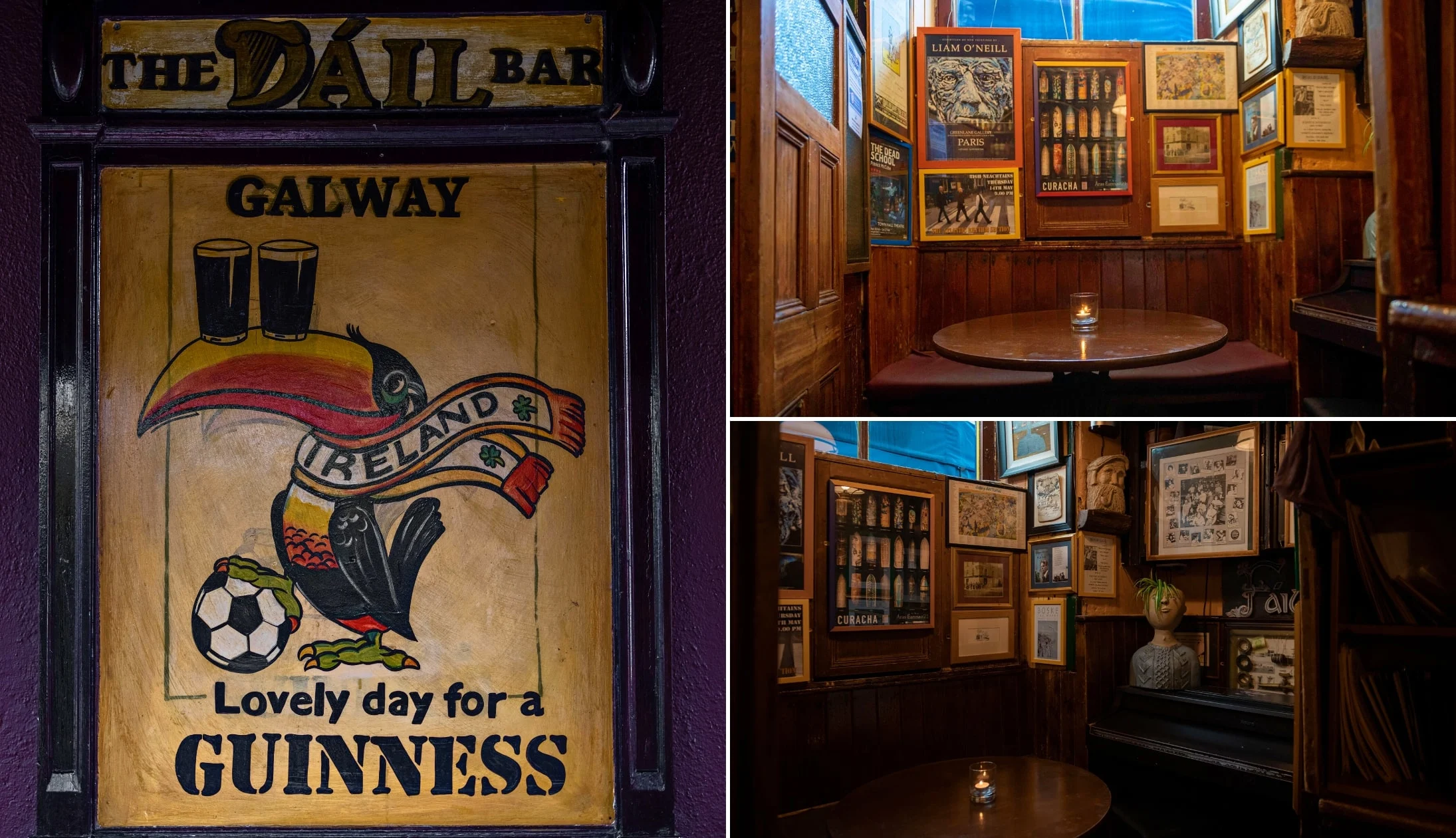
Photos courtesy Failte Ireland
You’ve had a busy aul day today, so it’s time to kick back and chill with food and, if you fancy, a drink and some live music.
Galway is a lively city regardless of the time of year. Here’s some spots worth checking out:
Our dinner recommendations
For dinner, we’ve got a few stellar recommendations: Ard Bia, The Quay Street Kitchen, and Dela. Ard Bia is absolutely fantastic, but you need to book in advance for dinner.
The restaurant has a quirky interior and serves beautifully presented modern dishes.
The Quay Street Kitchen has a great selection of vegan and vegetarian-friendly dishes, and Dela has modern Irish cuisine on the menu.
Live music and trad bars
There’s some mighty pubs in Galway. After dinner, head out for drinks at either Tigh Neachtain or The Crane. Both are traditional pubs with a great atmosphere.
Trad music is an integral part of the city, with heaps of options to choose from. Our favourite spots are Crane Bar (mentioned above) and Tigh Chóilí.
Day 5: County Clare

Photos via Shutterstock
You’re saying goodbye to Galway today and heading over to Doolin for a couple night. The total drive time is less than 2 hours depending on whether you take the coast road. But we have lots of places for you to stop on the way!
Doolin is a lovely village on Ireland’s west coast, known for its trad music.
Doolin accommodation recommendations
- Popular and central stays: West Haven House (short stroll from McDermott’s Pub) and Cullinan’s Guesthouse (great reviews and right across from Fitzpatrick’s Bar)
- Our favourites: Doolin Inn (a stone’s throw from Fisher Street), Fiddle + Bow Hotel (boutique and very central) and Hotel Doolin (good value and nice and central)
Stop 1: Dunguaire Castle
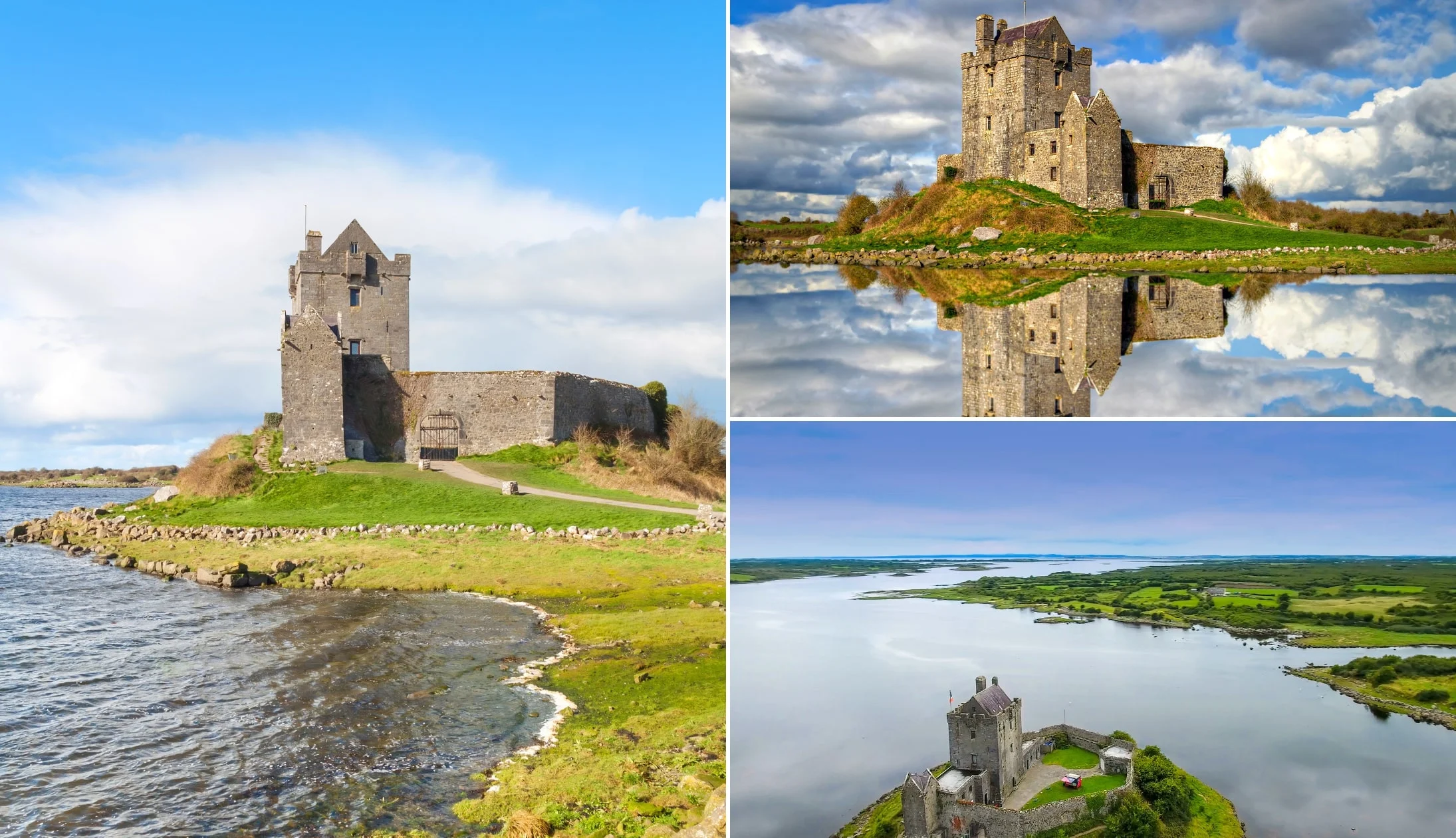
Photos via Shutterstock
Dunguaire Castle is a 35-minute drive from Galway. The castle was built in 1520 and belonged to the O’Hynes clan. In 1912, the castle was bought by writer Oliver St. John Gogarty.
During his ownership, he restored the castle and hosted several famous writers, including W.B. Yeats and George Bernard Shaw.
The enchanting castle sits on the shores of Galway Bay and has an impressive 75-foot tower. We’d recommend spending at least an hour here, walking the grounds and taking a self-guided tour.
According to legend, if you stand at the front gate and ask a question, you’ll have an answer by the end of the day!
Stop 2: Aillwee Cave

Photos via Aillwee Caves on FB
Your next stop, the Aillwee Cave, is around 27 minutes from Dungaire. The Aillwee Cave is a fascinating underground system, full of caverns, rock formations, and even the bones of an ancient bear!
The site is close to the Birds of Prey Centre, a unique and educational experience involving some of the world’s top birds of prey.
We’d recommend spending at least one hour at this stop, or even longer if you visit both attractions. The Aillwee Cave tour lasts 45 minutes, passing by an underground waterfall and over bridged ravines.
At the Burren Birds of Prey Centre, you’ll be able to see predators like owls, vultures, and hawks, and possibly watch a 45-minute flying demonstration.
Stop 3: Poulnabrone Dolmen

Photos via Shutterstock
Only 10 minutes from the Aillwee Cave, Poulnabrone Dolmen is a large portal tomb that dates back to the Neolithic period (between 4200 BC and 2900 BC). It’s one of the most famous dolmens in the country and one of the most photographed.
When it was excavated in the late 1980s, around 33 remains were discovered buried underneath, alongside various objects. It’s a really interesting piece of ancient Irish history and free to visit.
Stop 4: Ballyvaughan for lunch
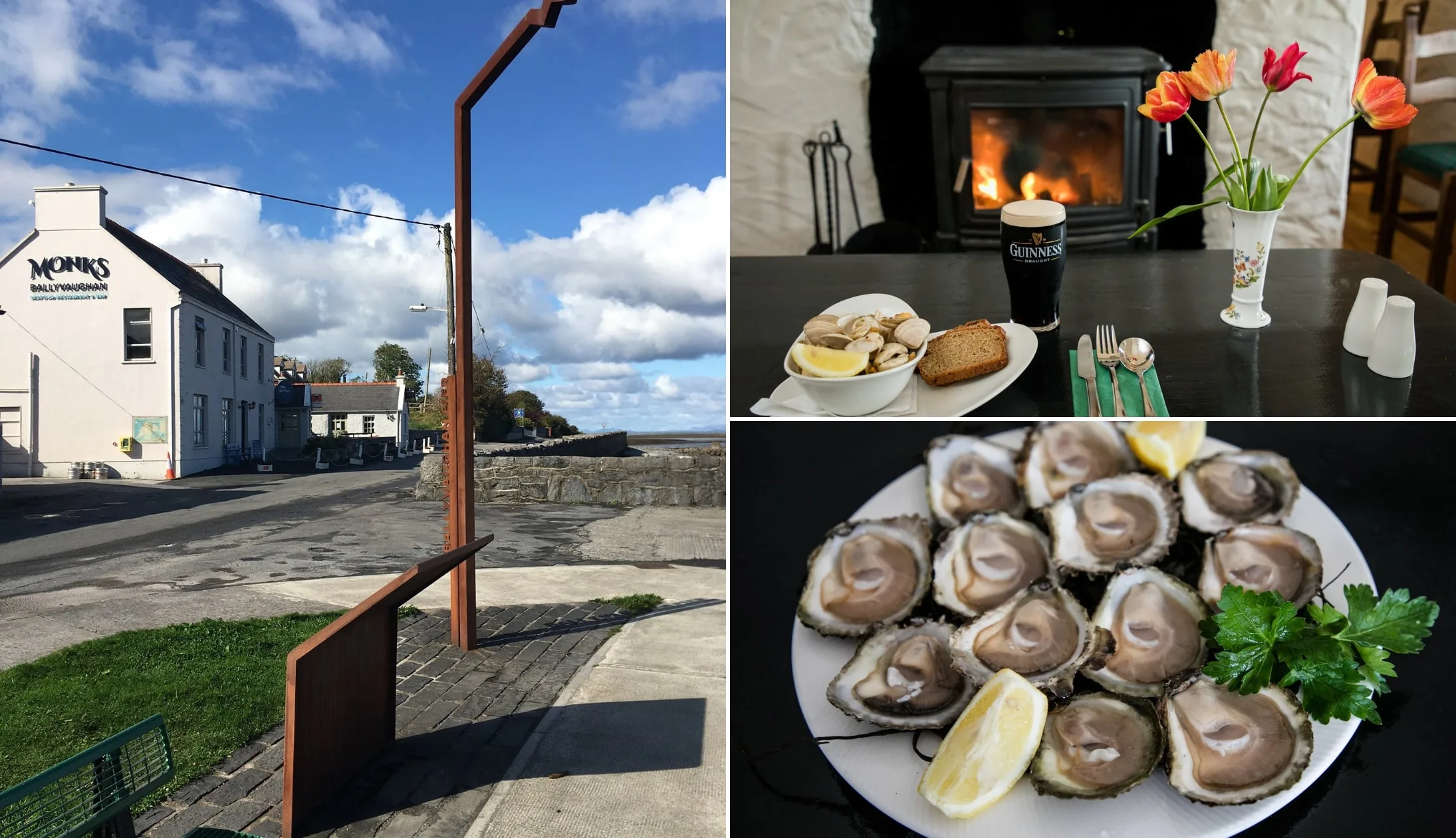
Photos via Monk’s on FB
It’s time to head to the quaint seaside village of Ballyvaughan, only 13 minutes from Poulnabrone Dolmen. Our favourite places to eat in the village are Monks (a brilliant seafood restaurant with handpicked Galway Bay oysters), The Wild Atlantic Lodge (a beautiful restaurant with delicious Irish cuisine), or The Larder (a cosy cafe with sandwiches, soup, and quiches).
Stop 5: Fanore Beach

Photos via Shutterstock
Fanore Beach is 18-minutes from Ballyvaughan. It’s a gorgeous beach backed by rolling sand dunes. The exposed beach is a popular spot for swimmers and surfers, and in the summer there’s a lifeguard service and a surf school.
Take a scenic walk along the beach, and if you need to pop to the toilet after lunch, there are public toilets on-site (open seasonally in the summer).
Stop 6: Doolin

Photos courtesy of Chaosheng Zhang
The drive from Fanore Beach to Doolin usually takes around 25 minutes, but we would recommend giving yourself a little extra time.
There are some amazing views of the Burren along the way and you might want to pull over! Once you arrive at Doolin, check into your hotel and rest/freshen up/etc.
Stop 7: Cliffs of Moher

Photos via Shutterstock
Your next stop, the magnificent Cliffs of Moher are one of the area’s, (if not Ireland’s) most popular attractions.
The cliffs are a 15-minute drive from Doolin, with breathtaking views of the wild Atlantic, Galway Bay, and the Aran Islands.
There’s a visitor centre on-site, as well as 800 metres of paved walkways with viewing areas, and the historic O’Brien’s Tower. In our opinion, the visitor centre isn’t really anything that special, but you’ll get access to all three with the Cliffs of Moher Experience.
Stop 8: Dinner, drinks and music in Doolin
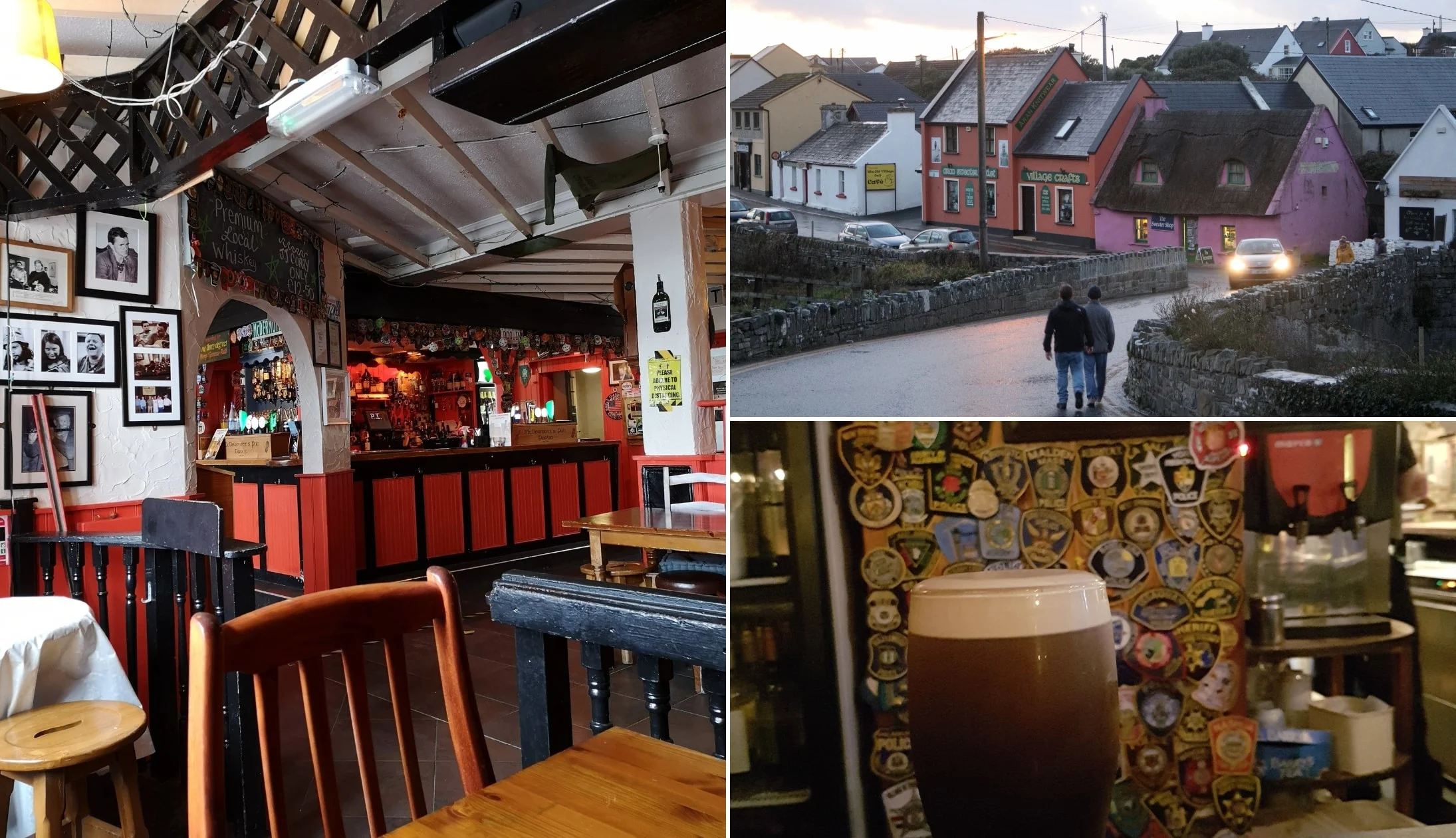
Photos by The Irish Road Trip
Although it’s fairly small, there’s some great restaurants in Doolin and there’s a handful of mighty pubs in Doolin, too.
Our Doolin food recommendations
We have quite a few recommendations for where to eat in Doolin. These are Riverside Bistro (the seafood pasta and lamb shank are delicious), Anthony’s at Doolin (modern Irish and international cuisine with a great selection of cocktails), and Russell’s Seafood Bar at Fiddle + Bow (amazing local seafood from award-winning chef Viv Kelly).
Our Doolin pub recommendations
Doolin is packed full of traditional Irish pubs, which are great for a pint (or a hearty pub meal if the restaurants above aren’t to your liking). Our favourites are McDermot, McGanns, Fitz’s, and Gus O’Connors.
The pubs above are also a good place to catch some live music, as well as Anthony’s at Doolin.
Day 6: Back To Dublin

Photos via Shutterstock
It’s the last day, and time to head back to Dublin. It’s a long-ish drive, so make sure to set out with enough time and to buy some snacks for the road.
You have to drive through two tolls so make sure to have a card that taps or cash! The drive usually takes about 3 hours so make sure to give yourself at least that much time, especially if you are trying to catch a flight.
Have plenty of time before your flight? Check out anything in the city that you weren’t able to see on days 1 and 2.
And that’s a wrap on this road trip
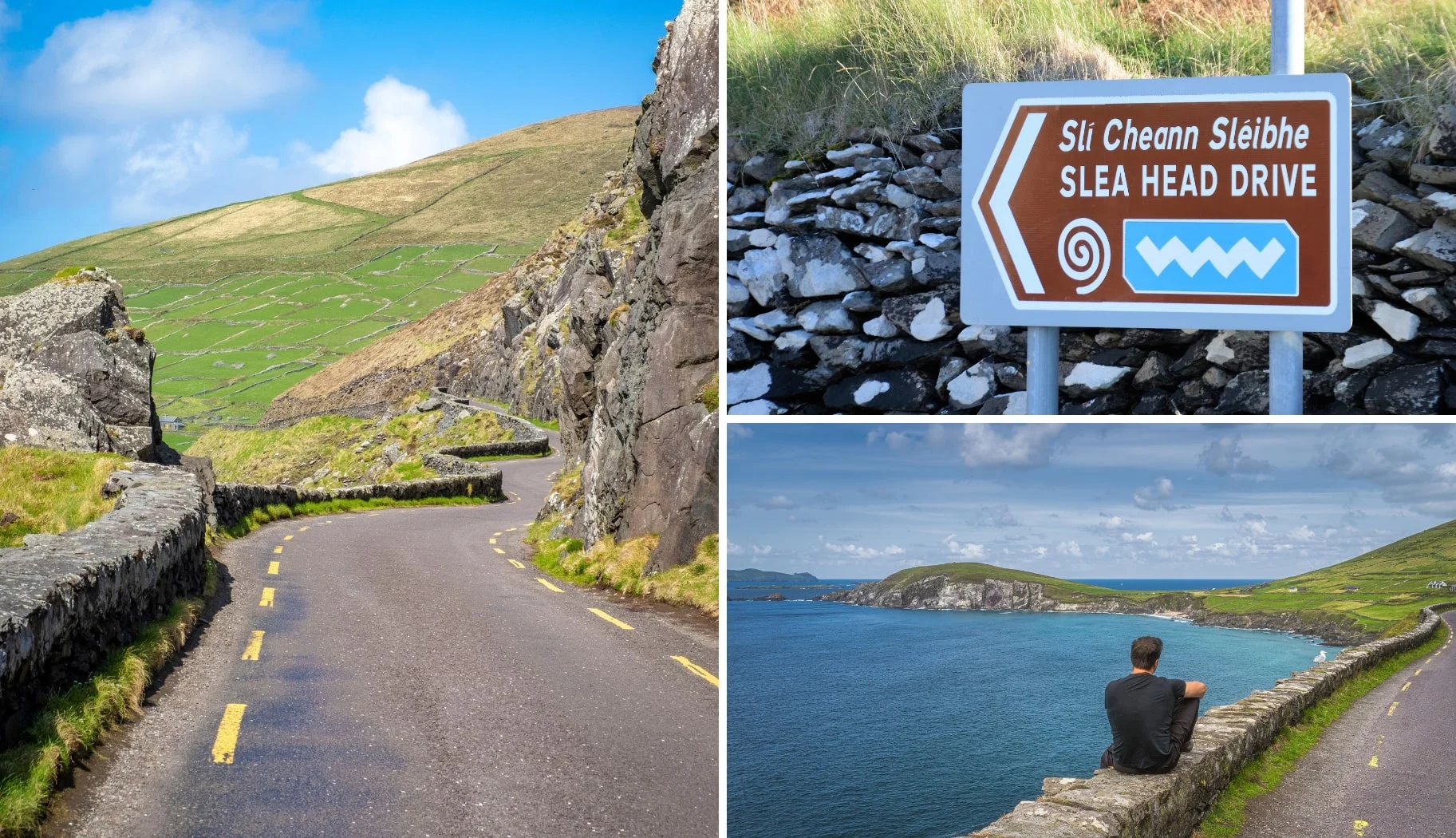
Photos via Shutterstock
We hope you found the above road trip guide useful. If you have any questions, ask in the comments below and we’ll do our best to help.
Or, if you’d like to browse our other Irish Road Trip itineraries, visit our Road Trip Hub – cheers!


Colleen
Saturday 25th of May 2024
Wow, this is great. Thx so much. Coming from Colorado, USA